-
Bahasa Indonesia
-
English
Oleh: Vincent Gaspersz, Lean Six Sigma Master Black Belt
American Society for Quality (www.asq.org) CMQ/OE, CQA, CSSBB, CQE, CQIA
American Production and Inventory Control Society (www.apics.org) CFPIM, CSCP
International Quality Federation (www.iqf.org) Six Sigma Master Black Belt
Registration Accreditation Board (www.exemplarglobal.org) Quality Management System Practitioner
“Without questions there is no learning. BUT You should not ask questions without KNOWLEDGE”
Dr. William Edwards Deming; October 14, 1900 – December 20, 1993
Dalam banyak tulisan, saya TELAH menyinggung bahwa SUCCESS Karier di dunia bisnis dan industri sangat tergantung pada EC (Effectiveness of Competence) yang merupakan intersection atau perkalian atau integrasi antara Attitude (A), Knowledge (K), dan Skills (S).
Catatan: EC = A x K x S. (Lihat Bagan 1 terlampir di atas).
Dalam banyak kasus lulusan perguruan tinggi di Indonesia memiliki nilai EC sangat rendah (antara 0 – 1) dengan kecenderungan menuju NOL. TIDAK ada korelasi yang kuat antara nilai Indeks Prestasi (IP) dan nilai Efektivitas Kompetensi (EC). Meskipun kita mengasumsikan seorang lulusan baru dari perguruan tinggi di Indonesia, karena kemauan, pembelajaran mandiri, dan kebijakan link and match dari perguruan tinggi TELAH mampu meningkatkan nilai Attitude (A) dan Knowledge (K) mencapai 100%, NAMUN keterampilan (Skills) yang belum diterapkan itu tetap masih bernilai nol (S = 0), maka nilai EC = A x K x S = 100% x 100% x 0% = 0.
Bagan 2 terlampir memberikan beberapa ilustrasi berikut:
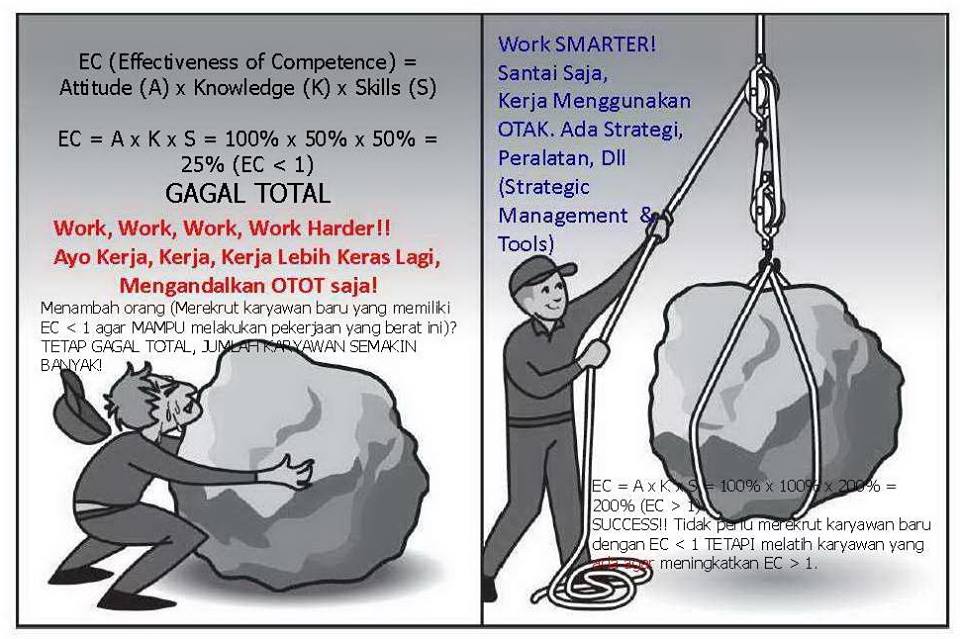
- Jika seseorang HANYA memiliki Attitude (A), katakanlah sempurna 100%, TETAPI ia TIDAK memiliki Knowledge (K) dan Skills (S), maka nilai EC = A x K x S = 100% x 0% x 0% = 0. Dalam kasus ini orang itu HANYA memotivasi diri sendiri saja untuk mengangkat “batu besar” TANPA ilmu pengetahuan dan keterampilan, sehingga hampir PASTI ia akan GAGAL mengangkat batu besar dalam Bagan 2 itu.
Catatan: Tulisan ini tidak membahas tentang mereka yang memiliki Bad Attitude (nilai NEGATIF) tetapi menginginkan SUCCESS, sebagai misal orang itu TIDAK MAU melakukan sesuatu setelah melihat “batu besar” dalam Bagan 2 terlampir itu.
- Jika seseorang yang TELAH memiliki Attitude (A) yang baik itu, mengetahui bahwa batu besar yang HARUS diangkat itu TIDAK MUNGKIN dilakukan sendiri, kemudian ia meminta bantuan orang lain sampai katakanlah 10 orang, maka ada kemungkinan batu besar itu terangkat TETAPI tindakan itu membutuhkan energi, waktu, dan mungkin uang sehingga dianggap TIDAK EFEKTIF dan TIDAK EFISIEN.
Catatan: dalam dunia nyata (praktek bisnis dan industri) yang mengandalkan pada Attitude (A) saja, cenderung akan merekrut tenaga-tenaga kerja baru untuk membantu mengangkat batu besar (beban tugas dan tanggung jawab) sehingga jumlah karyawan akan semakin banyak TANPA meningkatkan nilai Efektivitas Kompetensi (EC) dari karyawan-karyawan itu.
- Jika seseorang yang TELAH memiliki Attitude (A) yang baik itu juga TELAH memiliki ilmu pengetahuan (Knowledge) bahwa untuk mengangkat batu besar dapat menggunakan peralatan semacam katrol TETAPI belum berpengalaman (Skills) menggunakan katrol itu, maka nilai EC juga masih dianggap nol, Karena: EC = A x K x S = 100% x 100% x 0% = 0. Dalam hal ini ia MASIH GAGAL mengangkat batu besar itu yang dalam dunia nyata diibaratkan sebagai GAGAL mengemban beban tugas dan tanggung jawab yang besar.
- Seseorang baru dapat dianggap MAMPU bekerja secara Efektif dan Efisien, jika nilai EC minimum sama dengan satu (EC = 1), yaitu: (a) ia memiliki Attitude (A) yang baik, yaitu: ia MAU mengangkat batu besar, (b) ia memiliki ilmu pengetahuan dan teknologi (K), dalam contoh ini ia memiliki pengetahuan tentang peralatan katrol agar memudahkan mengangkat beban yang berat, dan (c) ia memiliki keterampilan/Skills (S) menggunakan peralatan katrol itu agar mampu mengangkat batu besar seperti dalam Bagan 2 terlampir itu.
- Mereka yang berada pada tahap 4 (ilustrasi nomor 4) ini tentu saja akan terus-menerus meningkatkan nilai EC agar lebih besar daripada satu, sehingga mencapai SUCCESS karier dan SUCCESS lainnya dalam kehidupan nyata yang saya menyebut sebagai SUCCESS dalam Universitas Kehidupan sampai menunggu waktu diwisuda dengan gelar paripurna dan tertinggi dari Universitas Kehidupan, yaitu: Alm (Almarhum).
Pada saat sekarang ini kita mengetahui bahwa lulusan baru dari perguruan tinggi baik di Indonesia maupun luar negeri, sangat jarang (hampir mendekati NOL persen) yang berada dalam ilustrasi nomor 4 di atas, apalagi nomor 5!
Lulusan baru dari perguruan tinggi (apakah D3, S1, S2, maupun S3?) yang memiliki EC yang sangat rendah (antara nol sampai 1) ini mengharapkan bahwa sistem yang ada di dunia bisnis dan industri yang HARUS meningkatkan EC (Efektivitas Kompetensi) dari lulusan baru itu, melalui meningkatkan nilai-nilai Attitude (A), Knowledge (K), dan S (Skills). Pemahaman seperti ini dianggap keliru, karena pertimbangan berikut.
MASIH banyak permasalahan yang terjadi dalam dunia bisnis dan industri di Indonesia, yaitu: banyak perusahaan bisnis dan industri BELUM memiliki sistem pendidikan dan pelatihan industri yang professional. Beberapa perusahaan bisnis dan industri di Indonesia yang memiliki sistem pendidikan dan pelatihan industri yang professional biasanya adalah perusahaan-perusahaan besar yang memiliki jaringan internasional, misalnya: PT. Astra Group of Companies mengadopsi sistem pendidikan dan pelatihan dari Toyota Motor di Jepang), PT. Pertamina, PT. Telkom, dll. Dan agar diketahui sangat sedikit lulusan baru dari perguruan tinggi yang berhasil dalam mengikuti proses seleksi dari perusahaan-perusahaan besar ini.
CATATAN: ketika VG lulus program Doktor Teknik Sistem dan Industri dari ITB (IP = 4,0), ia GAGAL menjadi karyawan di PT. Pertamina di tahun 1991 (tidak diterima dalam proses seleksi). TETAPI dalam proses beberapa tahun kemudian, VG diundang menjadi Konsultan untuk Membangun Sistem Manajemen Kinerja berbasis Malcolm Baldrige Criteria for Performance Excellence (MBCfPE) di PT. Pertamina dan menjadi instruktur tamu di Pertamina Learning Center (PLC)!
Saya sering kali merasa PRIHATIN ketika mengetahui bahwa seseorang lulusan baru dari perguruan tinggi, ketika memasuki dunia bisnis dan industri yang BELUM memiliki sistem pendidikan dan pelatihan industri, menjadi TIDAK TAHU harus berbuat apa-apa karena manajemen perusahaan juga masih sibuk dengan cara-cara tradisional untuk mengangkat batu besar mengandalkan tenaga manusia saja (mengandalkan Attitude saja).
Bisa dihitung berapa kerugian (opportunity loss) dari bangsa dan negara Indonesia sebagai akibat ke-TIDAK EFEKTIF-an dan ke-TIDAK EFISIEN-an dari sistem pendidikan dan pelatihan sejak PAUD (Pendidikan Anak Usia Dini) sampai Universitas kemudian berlanjut sampai bertahun-tahun bahkan mencapai puluhan tahun seseorang menjadi TIDAK MAMPU meningkatkan nilai Efektivitas Kompetensi (EC) di dunia bisnis dan industri Indonesia. Berdasarkan FAKTA ini, maka pengelola perguruan tinggi di Indonesia seyogianya HARUS menyadari dan memahami hal-hal di atas, sehingga TANGGUNG JAWAB bukan sekedar mewisudakan ribuan lulusan baru dengan kata-kata motivasi saja (mengandalkan Attitude saja), TANPA membekali lulusannya dengan Knowledge (K) dan Skills (S) yang cukup. Agar dicatat bahwa SUCCESS dalam dunia nyata (Universitas Kehidupan) bergantung pada seberapa besar nilai Efektivitas Kompetensi (EC) yang merupakan intersection atau perkalian atau integrasi antara Attitude (A), Knowledge (K), dan Skills (S).
Berdasarkan pengalaman saya pribadi yang TELAH memasuki dunia praktek bisnis dan industri mulai dari Management Trainee (MT) sejak 1991 ketika lulus dari program Doktor Teknik Sistem dan Industri ITB (IP = 4,0), telah mengikuti berbagai kursus manajemen professional termasuk memperoleh kompetensi profesional, pengalaman implementasi sistem-sistem manajemen lebih dari 25 tahun, dll, sehingga TELAH memiliki nilai Efektivitas Kompetensi (EC) di atas satu (mungkin 200%, 300% sampai tak terbatas, karena saya juga masih terus-menerus belajar menggunakan PDCA Management Framework), merasa yakin bahwa Indonesia MAMPU membangun MODEL Sistem Pendidikan dan Pelatihan sejak PAUD (Pendidikan Anak Usia Dini) sampai Universitas agar menghasilkan lulusan baru perguruan tinggi yang memiliki nilai EC (Efektivitas Kompetensi) di atas satu, minimum sama dengan satu. Ide saya adalah membangun laboratorium PRAKTEK Bisnis dan Industri yang professional di dunia perguruan tinggi, mengikuti model pendidikan di fakultas-fakultas kedokteran di seluruh dunia (termasuk Indonesia), sehingga menghasilkan Entrepreneurs dan/atau Intrapreneurs yang bekerja pada perusahaan-perusahaan bisnis dan industri (yang didirikan oleh Entrepreneurs) seperti ditunjukkan dalam Bagan 3 terlampir.

Sekolah dan Perguruan Tinggi yang MASIH menerapkan model pembelajaran abad ke-20 dan TIDAK MAU mengadopsi model pembelajaran abad ke-21 HANYA akan menghasilkan lulusan yang TIDAK BERKOMPETEN (EC = 0) di pasar tenaga kerja, yang pada akhirnya sekolah dan perguruan tinggi itu akan ditinggalkan oleh masyarakat. Pembelajaran abad ke-21 adalah pembelajaran untuk HIDUP (learning for life) BUKAN sekedar pembelajaran untuk sekolah (learning for school), Model pembelajaran abad ke-21 ditunjukkan dalam Bagan 4 terlampir.
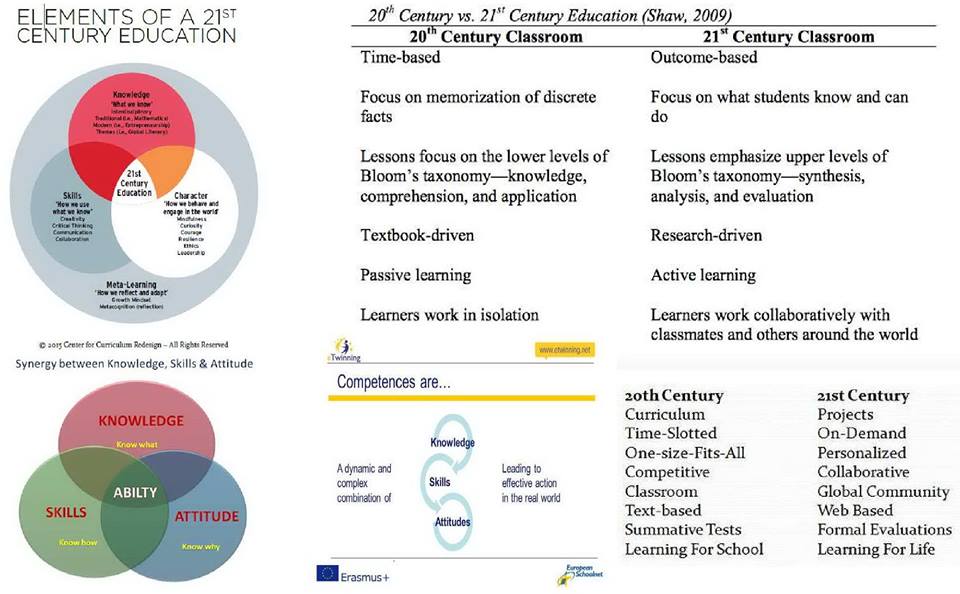
Contoh Model Pembelajaran untuk Perawat (Nurses) tentang Quality & Safety Education yang mengintegrasikan sekaligus Attitude (A), Knowledge (K), and Skills (S) sehingga meningkatkan nilai Efektivitas Kompetensi (EC) = A x K x S ditunjukkan dalam Bagan 5 terlampir.
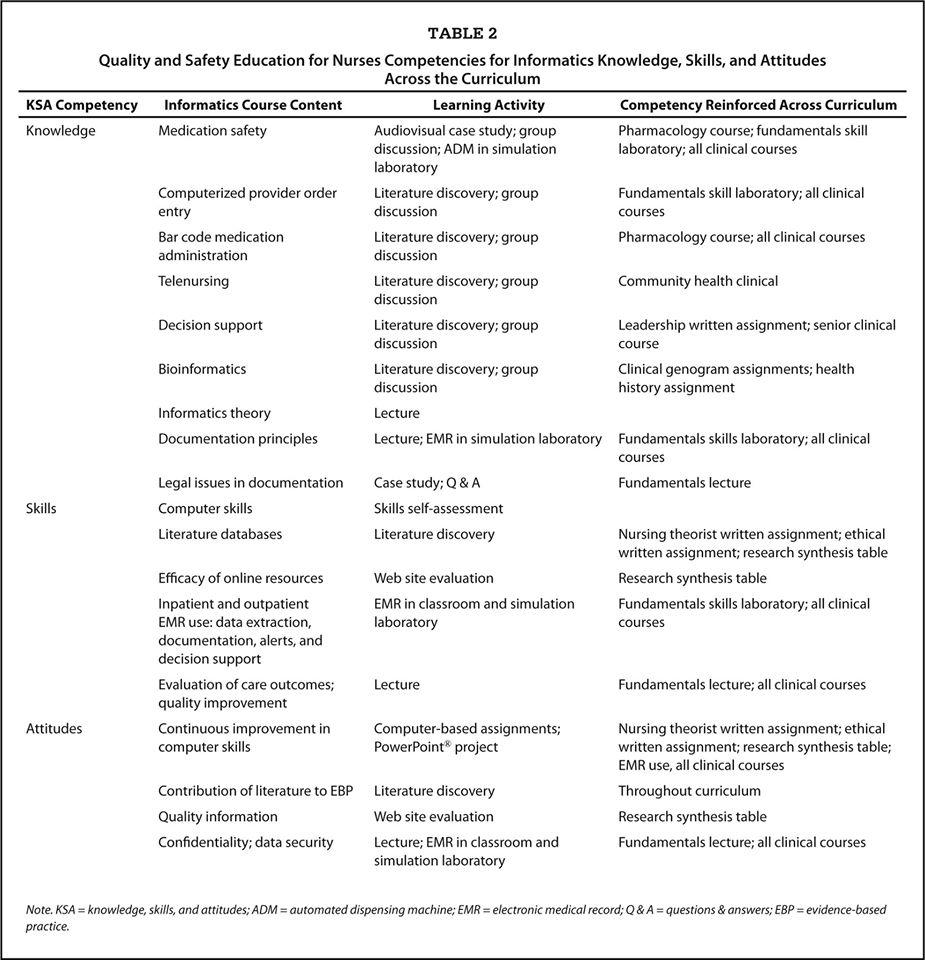
Sekolah dan Perguruan Tinggi dapat menggunakan PDCA “Competency” Management System Framework dalam Bagan 6 terlampir untuk meningkatkan Efektivitas Kompetensi (EC) lulusan mereka. Hal ini memungkinkan manajemen sekolah dan perguruan tinggi untuk melibatkan pihak bisnis dan industri secara aktif sehingga membentuk sistem sekolah dan perguruan tinggi yang terkoneksi langsung ke pasar tenaga kerja menggunakan PDCA Education Management System Framework seperti ditunjukkan dalam Bagan 7 terlampir.

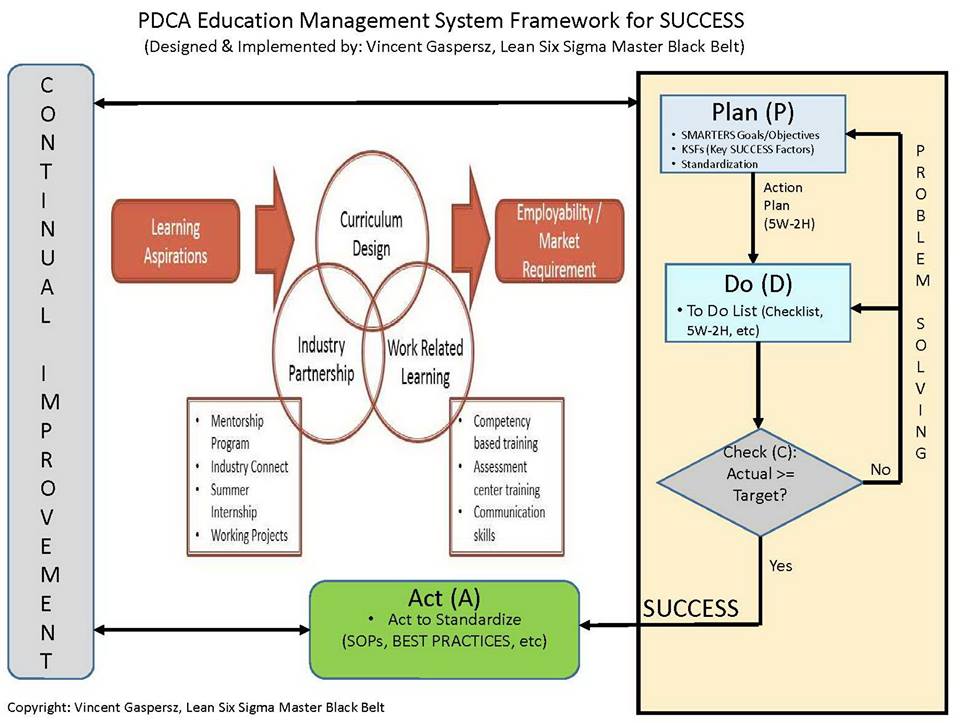
Setelah lulusan dari sekolah dan perguruan tinggi yang TELAH menerapkan model pembelajaran abad ke-21 itu memasuki pasar tenaga kerja, maka lulusan baru dari sekolah dan perguruan tinggi itu akan melanjutkan learning and growth di dunia bisnis dan industri, di mana dalam hal ini Manajemen Bisnis dan Industri juga TELAH membangun MODEL Sistem Pendidikan dan Pelatihan Industri yang professional, agar mempercepat lulusan perguruan tinggi itu mencapai SUCCESS karier dalam bisnis dan industri.
Strategi-strategi di atas akan MAMPU meningkatkan nilai Efektivitas Kompetensi (EC) dari Sumber Daya Manusia (SDM) Indonesia mencapai nilai jauh di atas satu sampai tak terbatas, yaitu mencapai KREATIFITAS dan INOVATIF seperti ditunjukkan dalam Bagan 8 terlampir.
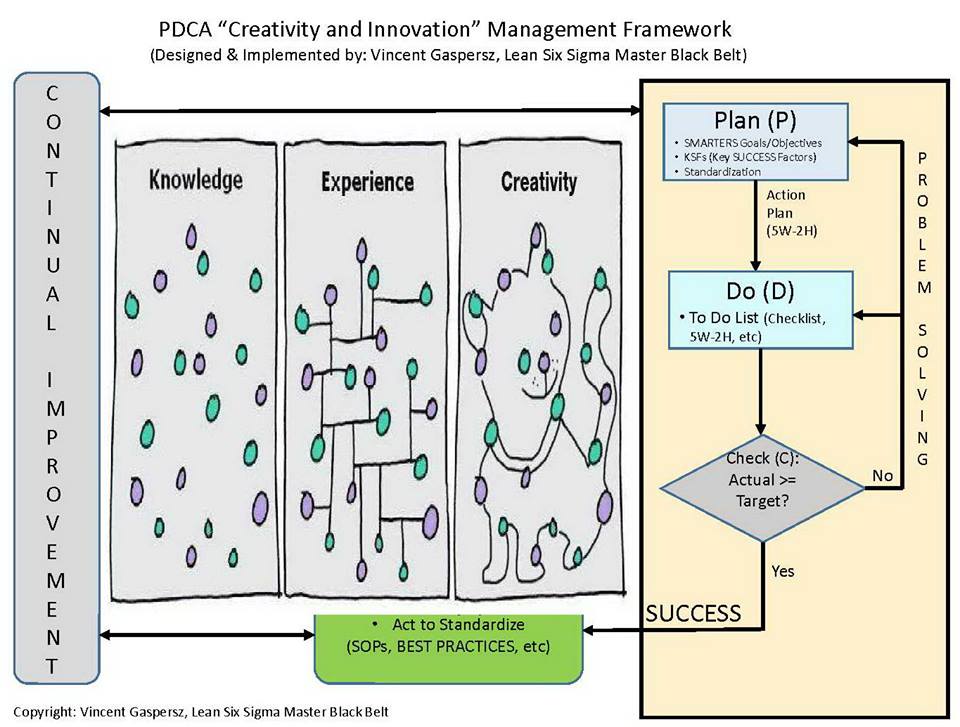
Jika kita mampu meningkatkan nilai Efektivitas Kompetensi (EC), maka kita akan mampu meningkatkan PRODUKTIVITAS yang secara otomatis akan menghemat waktu dan meningkatkan kesejahteraan uang (pendapatan ekonomi) bagi seluruh masyarakat Indonesia yang lulus dari sistem sekolah yang professional (Lihat Bagan 9 terlampir).
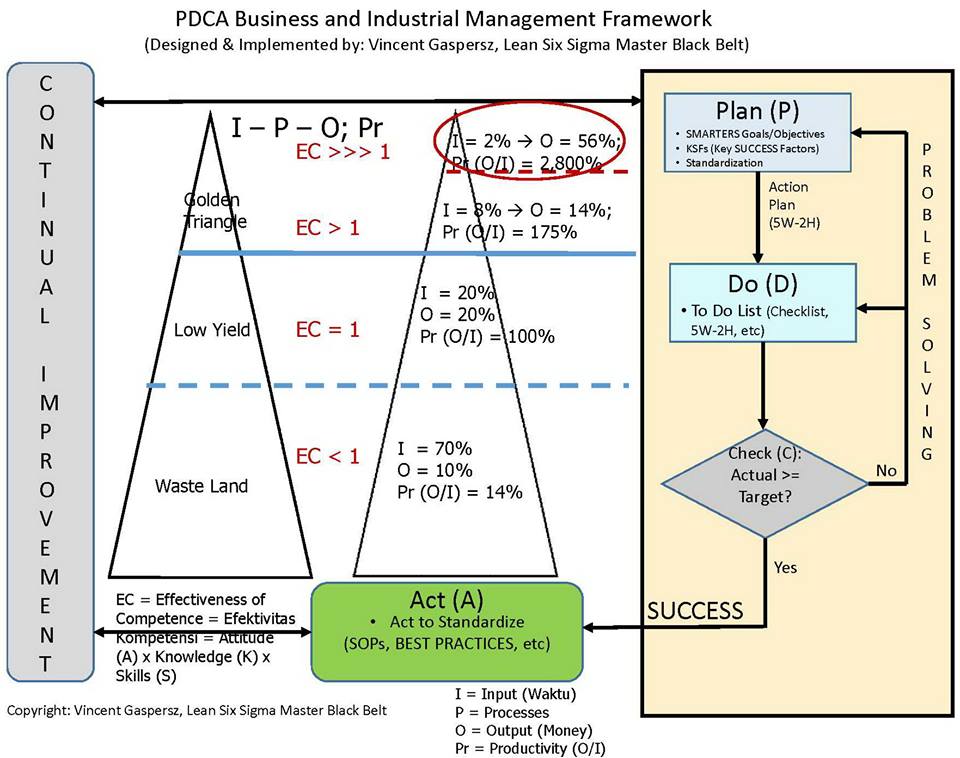
Salam SUCCESS.
Challenges For Universities in Indonesia To Increase EC (Effectiveness of Competence) Value of New Graduates
By: Vincent Gaspersz, Lean Six Sigma Master Black Belt
American Society for Quality (www.asq.org) CMQ/OE, CQA, CSSBB, CQE, CQIA
American Production and Inventory Control Society (www.apics.org) CFPIM, CSCP
International Quality Federation (www.iqf.org) Six Sigma Master Black Belt
Registration Accreditation Board (www.exemplarglobal.org) Quality Management System Practitioner
“Without questions there is no learning. BUT You should not ask questions without KNOWLEDGE”
Dr. William Edwards Deming; October 14, 1900 – December 20, 1993
In many writings, I HAVE mentioned that SUCCESSFUL career in business and industries is highly dependent on the EC (Effectiveness of Competence), which is the intersection or multiplication or integration between Attitude (A), Knowledge (K), and Skills (S).
Notes: EC = A x K x S. (See Chart 1 attached above).
In many cases, university graduates in Indonesia have very low EC value (between 0-1) with the tendency towards ZERO. There is NO strong correlation between the value of Achievement Index (GPA) and the Effectiveness of Competency (EC). Although we assume a new graduates from university in Indonesia, because of will, independent learning, and the link and match policy from the university, has BEEN able to increase the values of Attitude (A) and Knowledge (K) toward 100%, BUT that Skills have yet been applied is still zero (S = 0); consequently the value of EC = A x K x S = 100% x 100% x 0% = 0.
Chart 2 attached below gives some of the following illustrations:

- If someone ONLY has Attitude (A), say 100% perfect, BUT he/she DOES NOT have a Knowledge (K) and Skills (S), then the value of EC = A x K x S = 100% x 0% x 0% = 0. In this case, that person is ONLY motivating him/herself to lift the “big stone” WITHOUT knowledge and skills, so that almost SURELY he/she will FAIL to lift the big stone in that Chart 2.
Note: This article does not address those who have Bad Attitude (NEGATIVE value), but want to be SUCCESSFUL, for example those that DO NOT WANT to do something after seeing the “big stone” in that attached Chart 2.
- If someone who HAS had that good Attitude (A), knowing that the big stone that MUST be lifted is IMPOSSIBLE to do by him/herself, and then he/she asks for the help of others, up to say 10 people, then there is more possibility that big stone will be lifted, BUT that action requires energy, time, and possibly money, so that it is considered INEFFECTIVE and INEFFICIENT.
Note: in the real world (business and industries’ practices) that relies on just Attitude (A) alone, it will tend to recruit new workers to help lift the big stone (the workloads and responsibilities) so that the number of employees will increase more and more WITHOUT increasing the value Effectiveness of Competence ( EC) of those employees.
- If someone who HAS had that good Attitude (A) HAS also had Knowledge that the big stone can be lifted using an equipment such as a pulley BUT is inexperienced (Skills) in using that pulley, then the EC value of the EC will still be considered zero, because: EC = A x K x S = 100% x 100% x 0% = 0. In this case he/she STILL FAILS to lift that big stone; in the real world is likened to as FAIL to carry the great burden of the task and responsibility.
- Someone can only be considered to be ABLE to work Effectively and Efficiently, if the EC value, at minimum, equals to one (EC = 1), namely: (a) he/she has good Attitude (A), namely: he WANTS to lift the big stone, (b) he/she has the science and technology (K), in this example, he/she has the knowledge of the pulley equipment to facilitate lifting heavy loads, and (c) he/she has the skills (S) in using that pulley equipment in order to be able to lift the big stone as in that attached Chart 2.
- Those who are in this stage 4 (illustration number 4) will constantly improve the EC value to be greater than one, so as to achieve SUCCESSFUL career and other SUCCESSES in real life that I refer to as SUCCESS in the University of Life, waiting until the graduation time with the plenary and highest degree of the University of Life, namely: Alm (Almarhum // Deceased).
At this present time, we know that the new graduates from universities whether in Indonesia or abroad, are very rarely (almost close to zero percent) in the illustration number 4 above, let alone the number 5!
These recent graduates from higher education institutions (whether Diploma, Bachelor, Master, or Doctorate) who have very low EC (between zero and 1) are hoping that the existing system in the world of business and industries that MUST improve their EC (Effectiveness of Competence), by increasing the values ??of Attitude (A), Knowledge (K), and S (Skills). Such understanding is considered wrong, because of the following considerations.
There are STILL lots of problems that occur in the world of business and industries in Indonesia, namely: many business and industries’ companies have YET to have professional education and industry training system. Some of the business and industries’ companies in Indonesia which have had professional education and industry training systems are typically the large companies that have international networks, for example: PT. Astra Group of Companies adopting the education and training systems of Toyota Motor in Japan), PT. Pertamina, PT. Telkom, etc. And it is known to be very little that the new graduates from universities who are successful in the selection process at these large companies.
NOTE: when VG graduated from the Doctorate Systems and Industrial Engineering program from ITB (GPA = 4.0), he FAILED to become an employee at PT. Pertamina in 1991 (not accepted in the selection process). BUT in the process a few years later, VG invited to be a Consultant for Building Performance Management System based on the Malcolm Baldrige Criteria for Performance Excellence (MBCfPE) in PT. Pertamina and be a guest instructor at Pertamina Learning Center (PLC)!
I often feel CONCERNED when knowing that a new graduates from university, when entering the world of business and industry has NOT had education and industry training system, does NOT KNOW what to do because the company’s management are also still busy with the traditional ways of lifting the big stones relying on strength alone (relying on Attitude only).
It can be counted how much losses (opportunity losses) of the nation of Indonesia as a result of INEFFECTIVENESS and INEFFICIENCY of the education and training systems since ECD (Early Childhood Education) to the University, which then continues until years, even the tens of years, a person becomes UNABLE to increase his value of Effectiveness of Competence (EC) in the world of business and industries in Indonesia. Based on this FACT, then the managers of universities in Indonesia should be aware of and understand the things above, so that their RESPONSIBILITY is not just to graduate thousands of new graduates with words of motivation only (relies on Attitude alone), WITHOUT equipping the graduates with the sufficient Knowledge (K) and Skills (S). To be noted that SUCCESS in the real world (University of Life) depends on how much the value of Effectiveness of Competence (EC), which is the intersection or multiplication or integration between Attitude (A), Knowledge (K), and Skills (S).
Based on my personal experience that HAVE entered the practical world of business and industries, ranging from Management Trainee (MT) since 1991 when I graduated from the Doctoral program in Systems and Industrial Engineering ITB (GPA = 4.0); had participated in various professional management courses including obtaining professional competence, implementation experience of management systems for more than 25 years, etc., so that I HAVE had a value of Effectiveness of Competency (EC) beyond one (perhaps 200%, 300%, or to infinity, because I am still constantly learning by using PDCA management Framework), I feel confident that Indonesia is ABLE to build System MODEL of Education and Training since ECD (Early Childhood Education) to the University in order to produce recent university graduates who have EC (Effectiveness of Competency) above one, at minimum equals to one. My idea is to build a professional PRACTICAL laboratory of Business and Industries in the world of higher education, following the model of education in the faculties of medicine around the world (including Indonesia), producing Entrepreneurs and/or Intrapreneurs to work in business and industries’ companies (which are founded by Entrepreneurs) as shown in Chart 3 attached below.

Schools and universities that are STILL applying the 20th-century learning model of the 20th century and DO NOT WANT to adopt the 21st-century learning model will ONLY produce INCOMPETENT graduates (EC = 0) in the labor market, which in turn those schools and universities will be left behind by the public. 21st-century learning is learning for the LIFE, NOT just learning for school. 21st-century learning model is shown in Chart 4 attached below.

An example of Learning Model for Nurses about the Quality & Safety Education that simultaneously integrates Attitude (A), Knowledge (K), and Skills (S), so that increases the value of Effectiveness of Competency (EC) = A x K x S, is shown in Chart 5 attached below.

Schools and universities can use PDCA “Competency” Management System Framework, in Chart 6 attached below, to increase the Effectiveness of Competency (EC) of their graduates. This allows the management of schools and universities to actively involve businesses and industries so that to form the system of schools and universities that are directly connected to the labor market using PDCA Education Management System Framework, as also shown in Chart 7 attached below.


Having graduated from schools and universities that HAVE applied that 21st-century learning model and entering the labor market, the new graduates of those schools and universities will continue the learning and growth in the world of business and industries; in this case the management of Business and Industries have also built professional MODEL of Education and Industrial Training Systems in order to speed up those university graduates to achieve SUCCESSFUL careers in businesses and industries.
The above strategies will bae ABLE to increase the value of Effectiveness of Competence (EC) on Human Resources (HR) in Indonesia to reach the value of far beyond one towards infinity, which is to reach CREATIVITY and being INNOVATIVE as shown in Chart 8 attached below.

If we are able to increase the value of Effectiveness of Competence (EC), then we will be able to increase PRODUCTIVITY, which will automatically save time and improve the monetary welfare (economic revenue) for all Indonesian citizens who have graduated from professional school system (See Chart 9 attached below).

Best Regards for SUCCESS.










